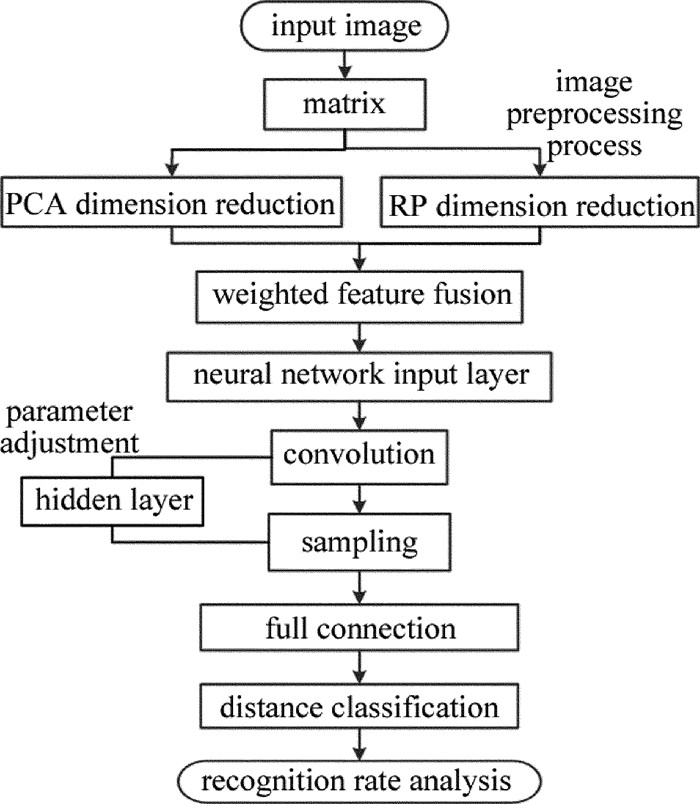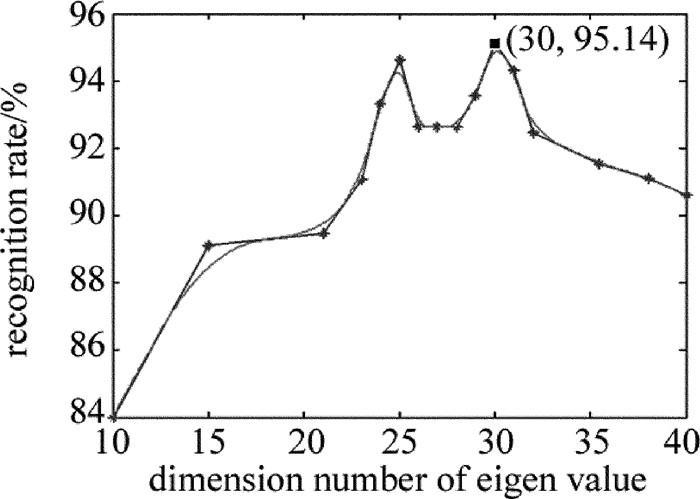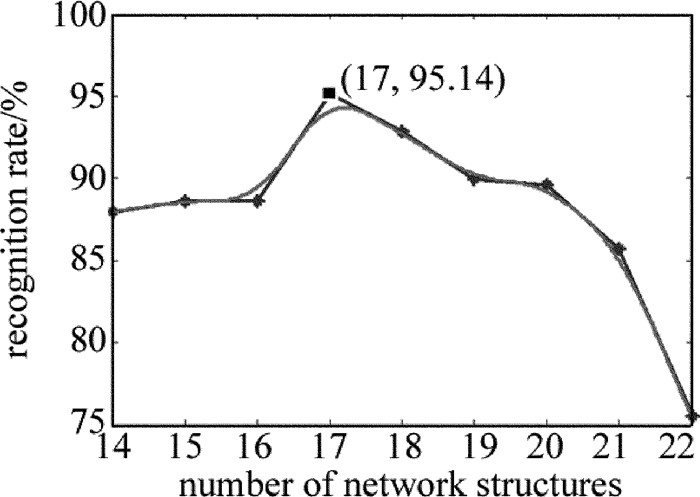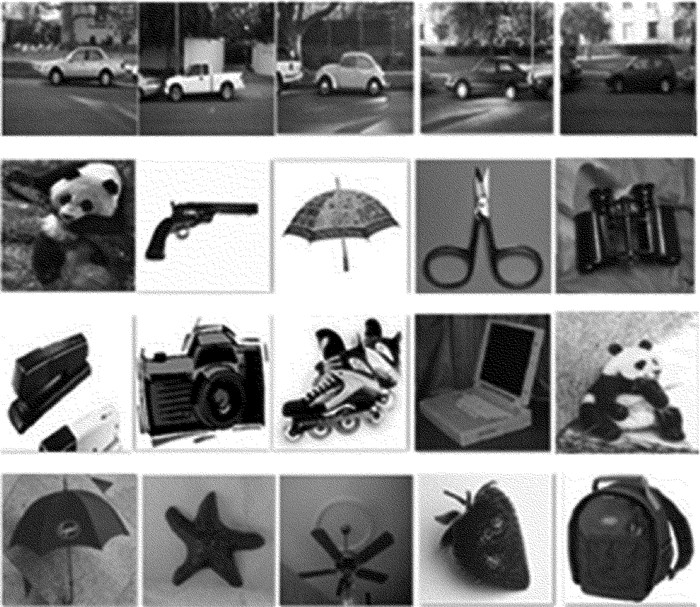Deep feature extraction and classification recognition algorithm based on weighting and dimension reduction
-
摘要: 为了降低卷积神经网络计算的复杂度,改善特征提取过程中的过拟合现象,解决经典网络模型不能有效处理大尺寸图片的问题,采用了加权联合降维的特征融合与分类识别算法,根据两特征的识别贡献率对主成分分析法(PCA)降维处理和随机投影(RP)处理结果进行加权融合,然后将结果提供给卷积神经网络进行处理,提取图像分类的高层特征,使用欧氏距离分类器对识别对象进行分类,并进行了理论分析和实验验证。结果表明,经过加权联合降维对数据进行预处理,PCA矩阵与RP降维矩阵之比重达到6:4,识别率高达96%以上。该算法有效提高了准确率,使大尺寸图片在深度学习网络中有良好的识别效果,改善了网络的适应性。Abstract: In order to reduce the computational complexity of convolution neural network, improve the over-fitting phenomenon in the process of feature extraction and solve the problem that the classic network model can not effectively deal with large size images, deep feature extraction and classification recognition algorithm based on weighting and dimension reduction was adopted. Based on recognition contribution rate of two features, the results of dimensionality reduction of principal component analysis (PCA) and random projection (RP) method were fused with weighted average, then the results were provided to convolution neural network and the high-level features of image classification were extracted. Euclidean distance classifier was used to classify the recognition objects. After theoretical analysis and experimental verification, the results show that the weight ratio of PCA matrix and RP reduction matrix is 6:4, and the recognition rate is over 96% after the preprocess of data by weighting and dimension reduction. This algorithm improves the accuracy effectively, makes large size pictures having good recognition effect in deep learning network and improves the adaptability of network.
-
-
Table 1 Determination of the dimension of eigenvalues
dimension 15 19 20 21 22 23 24 25 28 30 euclidean 89.9 88.9 89.9 94.4 94.4 94.4 92.9 94.4 94.3 93.9 cosine 90.4 90.4 90.4 94.4 94.9 94.4 93.9 93.9 94.5 96.4 correlation 86.9 90.4 88.9 92.4 94.6 92.4 92.9 92.9 94.3 94.9 mean 89.1 89.9 89.7 93.8 94.7 93.8 93.3 93.3 94.2 94.9 Table 2 Structure determination of deep learning
network structure(res) 14 15 16 17 18 19 20 21 22 euclidean 87.94 88.44 87.94 93.97 92.46 89.45 88.94 85.43 74.87 cosine 87.44 88.94 88.94 96.48 92.96 89.45 89.95 85.93 75.88 correlation 88.44 88.44 88.94 94.97 93.47 90.45 89.95 85.93 75.88 mean 87.94 88.61 88.61 95.14 92.80 89.95 89.61 85.76 75.54 Table 3 Determination of feature fusion coefficient of PCA and RP
weight ratio 0.5:0.5 0.1:0.9 0.2:0.8 0.3:0.7 0.4:0.6 0.6:0.4 0.7:0.3 0.8:0.2 0.9:0.1 euclidean 85.43 87.44 93.79 94.47 94.47 93.97 94.47 92.96 92.46 cosine 86.43 86.93 92.96 94.47 94.47 96.48 95.48 94.97 94.47 correlation 84.42 86.43 92.96 94.47 94.47 94.97 94.97 94.47 93.97 mean 85.43 86.93 93.29 94.47 94.47 95.14 94.97 94.13 93.63 Table 4 Comparison results of feature extraction method
feature extraction method method 1 method 2 method 3 method 4 recognition rate 86% 89% 93% 97% Table 5 Comparison results of distance method
classification method euclidean distance cosine distance correlation distance recognition rate 91.5% 93% 92% Table 6 Contrast results of three kinds of galleries
library name MIT library BioID library self-built library recognition rate 97% 90% 93% -
[1] SUN Y, CHEN Y H, WANG X G, et al. Deep learning face repersentation by joint identification-verification[J]. Advance in Neural Information Processing Systems, 2014, 27(12):30-60. http://arxiv.org/abs/1406.4773
[2] LLORCA D F, ARROYO R, SOTELO M A. Vehicle logo recognition in traffic images HOG features and SVM[C]//2013 16th International IEEE Conference on Intelligent transportation Systems: Intelligent Transportation Systems for All M-odes(ITSC 2013).New York, USA: IEEE, 2014: 2229-2234.
[3] QIAN F. Face recognition based on PCA[D]. Nanjing: Southeast University, 2003: 49-51(in Chinese).
[4] XU P, FU H. Facial expression recognition based on convolutional neural network, [J]. Artificial Intelligence, 2015, 34(12):45-47(in Chinese). http://d.old.wanfangdata.com.cn/Periodical/hzlgdxxb2015z1109
[5] XU F J, WU W, GONG Y, et al. Tracking using convolutional neural networks[J]. IEEE Transcations on Neural Networks, 2010, 21(10):1610-1623. DOI: 10.1109/TNN.2010.2066286
[6] BELHUMEUR P N, HESPANHA J P, KRIEGMAN D J. Recognition using class specific linear projection[J].IEEE Transactions on Pattern Analysis and Machine Intelligence, 1997, 19(7):711-720. DOI: 10.1109/34.598228
[7] ZHANG C, ZHANG Z. Improving multiview face detection with multi-task deep convolutional neural networks[C]//2014 IEEE Winter Conference on Application of Computer Vision(WACV). New York, USA: IEEE, 2014: 1036-1041.
[8] KRIZHEVSKY A, SUTSKEVER I, HINTON G E. ImageNet classification with deep convolutional neural networks[C]//International Conference on Neural Information Processing Systems. City of North Miami Beach, Florida, USA: Curran Associates Inc., 2012: 1097-1105.
[9] BENGIO Y. Learning deep arcjitectures for AI[J]. Foundations & Trends® in Machine Learning, 2009, 2(1):1-127.
[10] LIN Y M. face recognition based on deep learning[D]. Dalian: Dalian University of Technology, 2013: 14-26(in Chinese).
[11] SUN Y, WANG X G, TANG X. Deep learning face representation form predicting 10, 000 classes[C]//Proceedings of the 2014 IEEE Conference on Computer Vision and Pattern Recognition. New York, USA: IEEE, 2014: 1891-1898.
[12] ZHENG Y, CHEN Q Q. Deep lesrning and its new progress in object and behavior recogntion[J]. Journal of Image and Graphic, 2014, 19(2):175-184. http://www.en.cnki.com.cn/Article_en/CJFDTotal-ZGTB201402002.htm
[13] CHEN Ch. Research and implementation of face detection algorithm based on depth learning[D]. Chengdu: University of Electronic Science and Technology, 2017: 49-80(in Chinese).
[14] LANGKVISE M, KARLSSON L, LOU T A. Areview of unsuper vised feature learning and deep learning for time series modeling[J]. Pattern Recognition Letter, 2014, 42(5):11-24.
[15] XIONG Y, ZUO X Q, HUANG L, et al. Classification of color remote sensing images based on multi-feature combination[J]. Laser Technology, 2014, 38(2):165-171(in Chinese). http://en.cnki.com.cn/Article_en/CJFDTotal-JGJS201402005.htm
[16] LIU B. Infrared face recognition method based on random projection and sparse representation[D]. Xi'an: Xi'an Electronic and Science University, 2009: 2-9(in Chinese).
[17] SUN J G, MENG F Y. A weighted weighted fusion face recognition algorithm[J]. Journal of Intelligent Systems, 2015, 12(7):4-7(in Chinese). http://d.old.wanfangdata.com.cn/OAPaper/oai_doaj-articles_aaf033868e15109e45f8ad3772dda06a
[18] ZHANG B, LIU J F, TANG X L. Multi-scale video text detection based on corner and stroke width verification[C]//Visual Communications and Image Processing (VCIP), 2013. New York, USA: IEEE, 2014: 1-6.
[19] ZOU G F, FU G X. Multi pose face recognition based on weighted mean face[J]. Computer Application Research, 2017, 11(7):1-7(in Chinese). http://d.old.wanfangdata.com.cn/Periodical/jsjyyyj201810066
[20] CHAN T H, MA Y. A simple deep learning baseline for image classification[J]. IEEE Transactions on Image Processing, 2015, 11(4):10-17. http://europepmc.org/abstract/MED/26340772




 下载:
下载:







